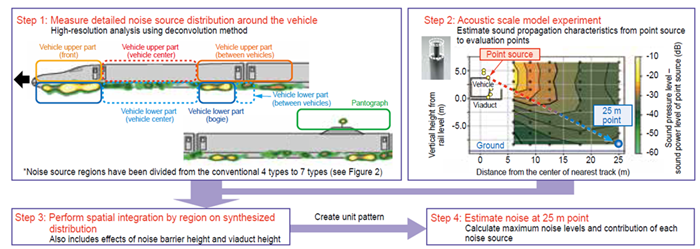20. Method for Detailed Prediction of Contribution of Each Noise Source on Wayside Noise Generated by Shinkansen Vehicles
Prediction methods for the wayside noise level (at an evaluation point 25 m away from the center of the nearest track) and the contribution of each noise source during Shinkansen vehicle running is utilized in determining appropriate noise barrier heights when increasing running speeds, introducing new vehicle models, or opening new lines. In this study, in evaluating the effectiveness of noise reduction measures such as modifying the shape of specific vehicle components, there has been a need for more detailed breakdowns of the contribution of each noise source.
In this study, we developed a method for predicting wayside noise by using high-resolution noise source distributions around vehicles measured with a two-dimensional microphone array and applying sound propagation characteristics of point source (Figures 1 and 2). Here, propagation characteristics refer to the level difference between the sound power of a point source placed around the vehicle and the sound pressure at the evaluation point, as determined through acoustic scale model experiments (1/20 scale). These characteristics are experimentally derived and account for sound attenuation effects such as diffraction and sound insulation. In particular, a new method employing a point source device capable of generating spherical waves has made such acoustic scale model experiments feasible.
This prediction method can be used for preliminary studies during the vehicle design phase, evaluation of running tests, modifications of the shape of specific components, and evaluation of the effectiveness of ground-based noise barriers and their sound insulation performance. Moreover, since this method can predict wayside noise under various conditions such as when modifications of the shape of specific components are applied to the entire train set, it can also contribute to reducing the number of running tests.
Other Contents
- 19. Two-Step Cross-Sectional Tunnel Entrance Hood
- 20. Method for Detailed Prediction of Contribution of Each Noise Source on Wayside Noise Generated by Shinkansen Vehicles
- 21. Integrated Control Method for Railway Energy Storage Systems Enabling the Use of Renewable Energy
- 22. Development and Commercial Operation Demonstration of High-capacity Superconducting Feeding for Urban Commuter Lines
- 23. Safety Assessment of Hydrogen Fuel Cell Multiple Units
- 19. Two-Step Cross-Sectional Tunnel Entrance Hood
- 20. Method for Detailed Prediction of Contribution of Each Noise Source on Wayside Noise Generated by Shinkansen Vehicles
- 21. Integrated Control Method for Railway Energy Storage Systems Enabling the Use of Renewable Energy
- 22. Development and Commercial Operation Demonstration of High-capacity Superconducting Feeding for Urban Commuter Lines
- 23. Safety Assessment of Hydrogen Fuel Cell Multiple Units


